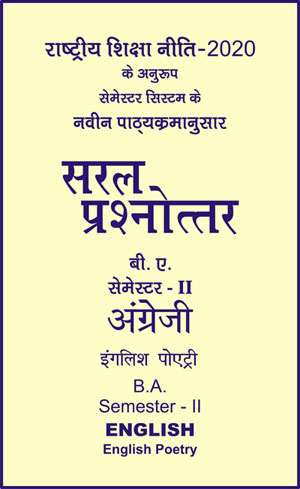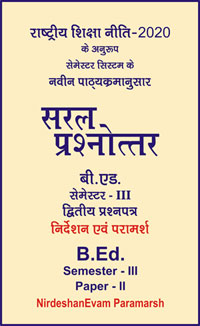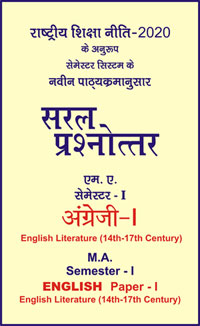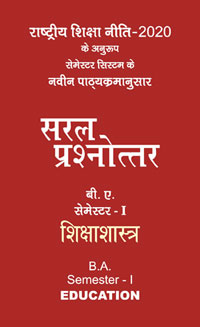|
बी ए - एम ए >> बीए सेमेस्टर-2 - अंग्रेजी - इंगलिश पोएट्री बीए सेमेस्टर-2 - अंग्रेजी - इंगलिश पोएट्रीसरल प्रश्नोत्तर समूह
|
|
|||||||
बीए सेमेस्टर-2 - अंग्रेजी - इंगलिश पोएट्री
Chapter - 17
Rhetoric and Prosody -
Practical Criticism
Introduction
Practical Criticism
Richard's influence rests primarily on his Practical Criticism (1929) which is based on his experiments conducted in Cambridge in which he distributed poems, stripped of all evidence of authorship and period, to his pupils and asked them to comments on them. He analyses factors responsible for misreading of poems. Even a "reputable scholar" in vulnerable to these problems.
Rhetoric
"Rhetoric" has usually been defined as the study of methods of using language to persuade other people. Guides to rhetoric often list, explain, and illustrate such figures of speech. "Prosody" refers to the study of meter, or regular patterns of rhythm, especially in poetry.
Rhetoric in Literature
Rhetoric is the are of persuasion through communication. It is a form of discourse that appeals to people's emotions and logic in order to motivate on inform. The word "rhetoric" comes from the Greek "rhetoric's" meaning "oratory."
There are three primary ways to make persuasive appeal. These are- logos, ethos and pathos. These three rhetorical appeals are at the heart of communication.
The three branches of rhetoric include deliberative, judicial and epidictic. If you ask a rhetorical question it means you don't neussarity expect an answer, out you do want an occasion to talk about something. Rhetoric is the area of written or spoken communication. But now-a-day if we say something is rhetorical, we usually mean that its only good for talking.
The Rhetorical square consists of four elements that mature when analysing a text. The four elements are:
(1) Purpose.
(3) Audience
(2) Message
(4) Voice.
Rhetoric is the study and art of writing and speaking persuasively. It aim is to inform, educate, persuade or motivate specific audience in specific situations.
Prosody
Prosody, the study of all elements of language that contribute towards acoustic and rhythmic effects, chiefly in poetry but also in prose.
Prosody-the rhythm, stress and intonation of speech-provides important information beyond a sentence's literal word meaning. Prosody is also used to provide semiotic information. For example, speakers spontaneously raise the pitch of their voice when describing an upwards motion.
The difference between prosody and poetry is that prosody is (linguistics) the study of rhythm, intonation, stress and related attributes in speech while poetry is the class of literature comprising poems.
Practical Criticism
Practical Criticism is a form of literary analysis which focus exclusively on the text, ignoring such extraneous factors as authorial intention and historical context.
The term originates with an experiment performed on Cambridge literature students by I.A. Richard. The students were given a selection of Poems to read and comments on, but they were not given the titles of the poems, nor were they told anything about who the authors of the poems were. The idea was that the students should judge the texts before them solely based on what they had in front of them. Richards was amazed at how Poorly (in his view) the students performed and concluded that what was needed was more practical instruction in the art of reading texts. The results of his experiments (Richards' background was in fact in psychology) are written up in the appropriately titled practical criticism. A study of Literary Judgement (1929), which became a kind of handbook for the discipline of literary studies and had an enormous influence. It was however, his former student, FR. Leaves, who popularised the method of 'close reading' through the journal, scrutiny, which he founded. It became the default way of reading literary texts in most of the Anglophone world. Even after its influence waned in universities due to the impact of structuralism and post structuralism in the 1960s, it remained very much in force in high schools and colleges well in to the 1980s. The exception to this rules was the US, which was instead gripped by New Criticism a home grown mutation of Practical Criticism, that was similarly concerned to focus only on the text.
The strength of Practical Criticism was that it set aside the merely impressionistic responses found in what terry Eagleton describes as the 'belle- lettristic waffle' of the then hegemonic Bloomsbury group of authors, and brought genuine rigour to the business of reading texts. Students were taught to better understand the effects of literary convention and technique (e.g., the role of metaphor) and were given free rein to pronounce judgement on the relative worth of specific texts.
Practical Criticism, mainly its leading avator F.R. Leavis, was virtually obsessed with deciding what did and did not belong in the canon of 'great texts' worthy or further study. While this enabled literary studies to develop standardised texts and more importantly standardised tests in school, thus explaining its incredible influence, it also led to standardised responses to texts and promoted the idea that only certain responses. Because practical criticism ignored both the author's and the reader's background and was only interested in so collided 'universals' like 'truth', it consciously reduced the range of meanings and text might in fact yield. It was this factor more than anything that led to its eventual demise as other methods celebrating the diversity of meaning came into fashion. But it was also attached from a political perspective for ignoring the significance of identity politics, particularly issues to do with gender, race, and sexuality. The plurality of possible readings that texts can give rise to is explored by reader-response critics.
Rhetoric
Rhetoric is a technique of using language effectively and persuasively in spoken or written form. It is an art of discourse, which studies and employs various methods to convince, influence, or please an audience.
Examples of Rehtoric in Literature:
Let us try analyse the use of rhetoric in some literary works:
Example 1: Paradise lost (By John Milton)
John Milton's Paradise lost has several examples of rhetoric.
To quote an example from Book V:
"....advise him of his happy state-
Happiness is his power left free to will,
Left to his own free will, his will though free
Yet mutable."
The repetition of the phrase "free will" emphasizes the theme of human reaction, which is making free choices, but the phrase "Yet mutable" rates ambiguity that, despite being free, Adam had to be careful, as a wrong act would make him lose his freedom.
Prosody
Definition of Prosody: A literary techniques, prosody is the study of meter, intonation, and rhythm of a poetic work. It is a phonetic term that uses meter, rhythm, tempo, pitch and lauders in a speech for conveying information about the meanings and structure of an utterance. In addition, prosody is an important element of language that contributes towards rhythmic and acoustic effects in a piece of meriting. It includes different elements, such as scansion, sound, pace and meaning.
Types of Prosody: There are four distinguishable prosodic metrical patterns, which are :
(1) Syllabic Prosody : Syllabic Prosody counts a fixed number of syllables in each line, while accent, tone and quantity plays a secondary role.
(2) Accentual Prosody : Accentual Prosody measures only the accents or stresses in a line of verse, while the overall number of syllables may vary in a line. It is very common in Germanic, old English and modern English verses.
(3) Accentual Syllabic Prosody : Accentual-syllabic prosody counts both the number of syllables and accents in each line. We commonly find it in English poetry.
(4) Quantitative Prosody : Quantitative prosody does not measure the number of syllabus, rather depending upon during of syllables. This can be determined by the amount of time used on pronunciation, such as a free-verse poem that consists of unmeasured lines. We find this type of prosody in Romon and classical Greek poetry and only very rarely in English poetry.
Examples of Prosody in Literature
Example 1: In my Gift or sullen Art (by Dylan Thomas)
"In my raft or sullen art
Exercised in the still night
When only the moon rages
And the lovers lie abed
With all their grief's in their arms,
I labour by singing light......
But for the common wages
Of their most secret heart."
|
|||||
- Chapter - 1 Forms of Poetry & Stanza Forms
- Objective Type Questions
- Answers
- Chapter - 2 Poetic Device
- Objective Type Questions
- Answers
- Chapter - 3 "Let Me Not to the Marriage of True Minds" (Sonnet No. 116)
- Objective Type Questions
- Answers
- Chapter - 4 "On His Blindness"
- Objective Type Questions
- Answers
- Chapter - 5 "Present in Absence"
- Objective Type Questions
- Answers
- Chapter - 6 "Essay on Man”
- Objective Type Questions
- Answers
- Chapter - 7 "Elegy Written in a Country Churchyard”
- Objective Type Questions
- Answers
- Chapter - 8 "The World is Too Much with Us"
- Objective Type Questions
- Answers
- Chapter - 9 "Ode on a Grecian Urn"
- Objective Type Questions
- Answers
- Chapter - 10 "Break, Break, Break"
- Objective Type Questions
- Answers
- Chapter - 11 "How Do I Love Thee?"
- Objective Type Questions
- Answers
- Chapter - 12 "Dover Beach"
- Objective Type Questions
- Answers
- Chapter - 13 "My Last Duchess'
- Objective Type Questions
- Answers
- Chapter - 14 "The Love Song of J. Alfred Prufrock"
- Objective Type Questions
- Answers
- Chapter - 15 "The Lake Isle of Innisfree"
- Objective Type Questions
- Answers
- Chapter - 16 "Church Going"
- Objective Type Questions
- Answers
- Chapter - 17 Rhetoric and Prosody - Practical Criticism
- Objective Type Questions
- Answers

 i
i 










